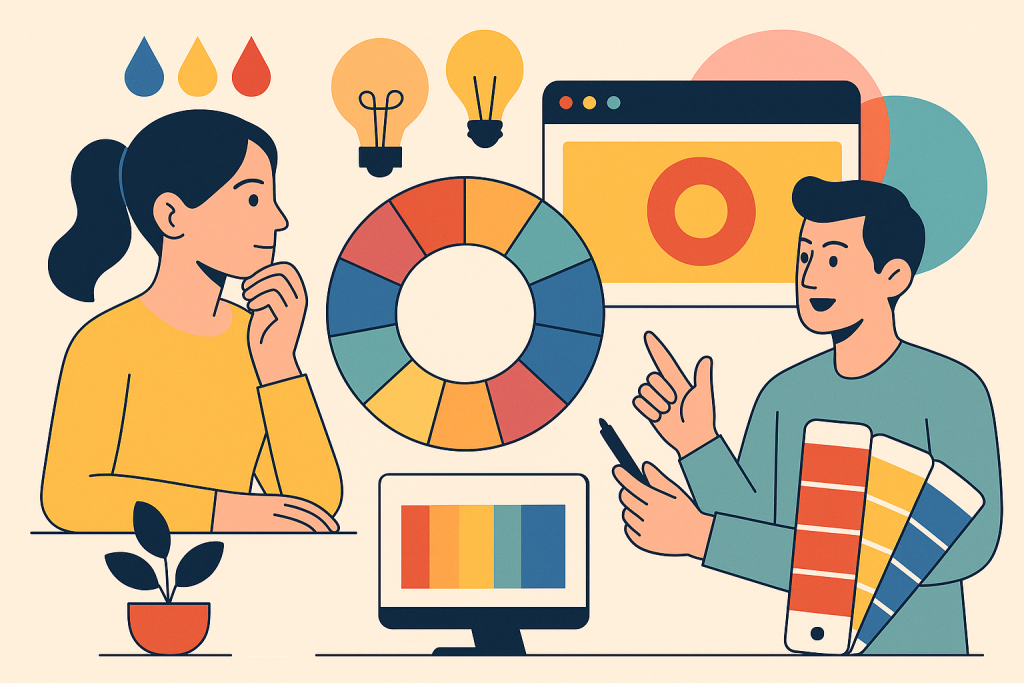The psychology of color in branding is a critical strategy. As consumer behaviors evolve and visual saturation dominates our digital and physical environments, brands are leaning into color psychology not just to stand out, but to connect deeply with their audiences. Strategic use of color can influence how people perceive a brand, affect their emotions, and ultimately drive purchasing behavior.
From earthy neutrals to bold futuristic palettes, emerging color trends in branding are telling stories, evoking emotions, and sparking consumer loyalty. This article explores how the psychology of color in branding is being leveraged by leading companies in 2025—and how your brand can benefit too.

Why Color Psychology Still Rules Marketing
According to research, up to 85% of consumers identify color as the primary reason they buy a particular product, and color alone boosts brand recognition by up to 80% (Verasolve 2025). These numbers aren’t just compelling—they’re a clarion call for brands to embrace color not as decoration but as persuasion.
Color impacts:
- First impressions (within 90 seconds)
- Perception of trust and reliability
- Emotional response and mood
- Impulse purchasing decisions
It’s no coincidence that tech companies rely on blue (trust), health brands use green (calm and growth), and luxury labels lean on black (elegance and exclusivity).
Emerging Color Trends Dominating Branding in 2025
1. Earthy Tones Reflecting Sustainability
One of the most talked-about colors in 2025 is Mocha Mousse, Pantone’s Color of the Year. It’s a deep, soothing brown that signals simplicity, authenticity, and a return to nature. With sustainability being a key driver in consumer choices, earthy tones are being used by brands to align themselves with values of environmental consciousness and mindfulness.
For example, eco-fashion and home décor brands have rebranded using muted browns, mossy greens, and clay tones to create a “grounded” aesthetic that appeals to eco-aware Gen Z and Millennial buyers (Pantone 2025; Homes & Gardens 2025).
“Consumers crave comfort and authenticity in a chaotic world. Mocha Mousse captures that desire beautifully.” — Pantone, 2025
2. Hyperpop Palettes: Vibrancy for the Digital Age
On the other end of the spectrum, we see the rise of hyperpop color palettes—think neon pinks, saturated purples, and electric blues. These colors are dominating industries like entertainment, tech, and youth fashion. Designed for attention-grabbing digital content, they appeal to a generation that values expression, boldness, and instant gratification.
This palette’s popularity stems from social media influence and AR/VR branding experiences, where standing out visually is the name of the game. According to VistaPrint (2025), such colors are also proven to increase dwell time on web interfaces and enhance engagement.
“The bolder the color, the longer the gaze.” — VistaPrint, 2025
3. Butter Yellow: Comfort Meets Innovation
Butter Yellow, a gentle pastel yellow with creamy undertones, has surged in popularity due to its soft, nurturing appeal. Brands that want to appear friendly, creative, and emotionally engaging are using this color across packaging, websites, and logos.
This shade stimulates creativity while offering a warm, welcoming tone. Psychological studies show that yellow boosts serotonin levels, which can increase perceived happiness and optimism in consumers (LinkedIn 2025).
Even interior icons like Gloria Steinem have embraced this shade in their living spaces for its timeless positivity (Homes & Gardens 2025).
4. Color Customization for Inclusivity
2025 has also seen a sharp rise in personalized color branding—an evolution driven by inclusivity and cultural nuance. Major global brands are creating region-specific campaigns that tweak colors based on local symbolism.
- Red may symbolize luck in China but warning in the U.S.
- White implies purity in Western cultures but can mean mourning in parts of Asia.
- Green stands for nature and growth globally but also Islamic heritage in the Middle East.
With international markets more accessible than ever, brand color choices are now filtered through a cultural lens. This shift ensures that brands maintain relevance and respect across diverse markets (Wikipedia 2025).
How to Leverage the Psychology of Color in Branding
Whether you’re a startup or a Fortune 500 brand, understanding and applying color psychology can drive meaningful results. Here’s how to do it right in 2025:
a. Define Your Brand’s Emotional DNA
Identify the core emotions you want to elicit in your audience. Is it trust? Excitement? Serenity? Let this guide your color palette.
- Blue = Trust, Dependability
- Red = Passion, Urgency
- Green = Growth, Health
- Yellow = Joy, Optimism
- Purple = Luxury, Creativity
b. Use Color to Create Cohesion Across Platforms
Your color palette should be consistent across digital, physical, and experiential branding. Whether it’s your app interface or store signage, continuity breeds familiarity—and trust.
c. A/B Test Color Variants for Conversion
In 2025, advanced marketing platforms allow real-time A/B testing of different color combinations. Test which shades perform best in emails, ads, and landing pages. Even minor hue adjustments can influence click-through and conversion rates.
d. Incorporate Accessibility Considerations
Color accessibility matters more than ever. Ensure your designs are inclusive for users with visual impairments or color blindness. Use high contrast and avoid relying on color alone to convey information.
e. Follow Industry Trends—but Don’t Overcommit
Stay inspired by trend forecasts but maintain your brand’s identity. For example, if neon isn’t your brand’s vibe, you can still reference the trend with strategic accents rather than a full rebrand.
Real-World Examples of Color Psychology in Action
- Apple: Often uses white and silver to convey minimalism and innovation. Their use of black packaging for Pro products implies exclusivity and premium status.
- Coca-Cola: The iconic red fosters feelings of excitement and passion—perfectly fitting for a fizzy drink brand.
- Spotify: Green and black combo promotes energy and movement while remaining grounded and modern.
- Glossier: Soft pinks and neutrals evoke femininity, warmth, and minimalism—key to their millennial-friendly brand.
Final Thoughts
Color is a silent ambassador of your brand. In 2025, the psychology of color in branding has evolved beyond choosing what looks good—it’s about what feels right to the consumer and what aligns with cultural and emotional expectations. Brands that strategically use color will not only attract attention but also build trust, influence behavior, and increase conversion.
In this increasingly visual world, your brand color isn’t just decoration—it’s communication.
References
- Verasolve. (2025). The Psychology of Color in Branding and Marketing. Available at: https://verasolve.com/the-psychology-of-color-in-branding-and-marketing-how-color-influences-behavior/
- Pantone. (2025). Color of the Year: Mocha Mousse. Available at: https://people.com/pantone-color-of-the-year-2025-mocha-mousse-8756820
- Homes & Gardens. (2025). Butter Yellow Trend in Gloria Steinem’s Home. Available at: https://www.homesandgardens.com/celebrity-style/gloria-steinem-butter-yellow-living-room
- LinkedIn. (2025). Color Psychology in Branding. Available at: https://www.linkedin.com/pulse/psychology-colors-branding-what-designers-need-know-ul5lc
- VistaPrint. (2025). Color Trends for 2024–2025. Available at: https://www.vistaprint.com/hub/color-trends
- Wikipedia. (2025). Color Symbolism. Available at: https://en.wikipedia.org/wiki/Color_symbolism






